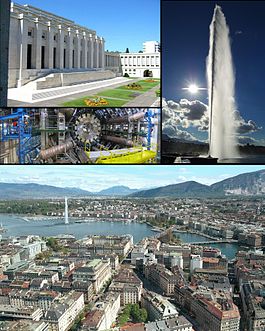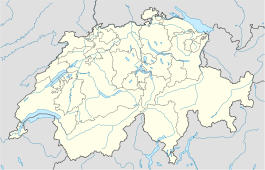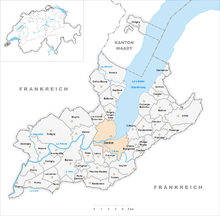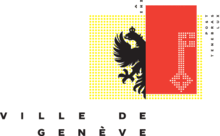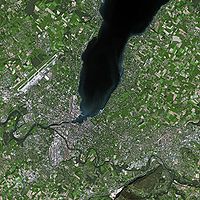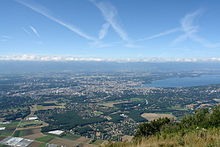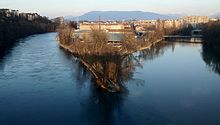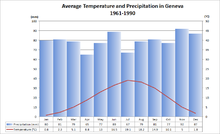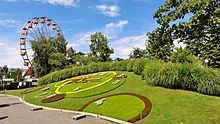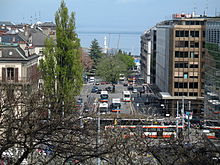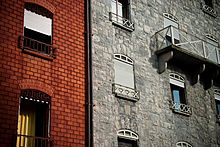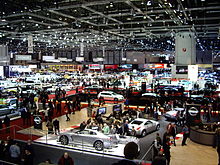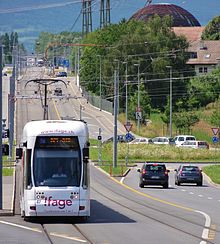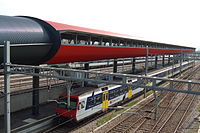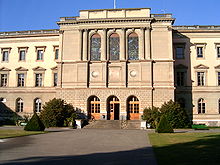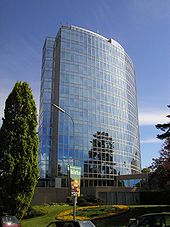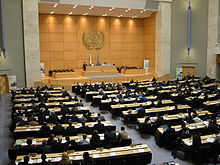
Geneva
About this schools Wikipedia selection
SOS Children, which runs nearly 200 sos schools in the developing world, organised this selection. Visit the SOS Children website at http://www.soschildren.org/
| Geneva | ||||||||||
|---|---|---|---|---|---|---|---|---|---|---|
| Top left: Palace of Nations, Middle left: ATLAS experiment at CERN, Right: Jet d'Eau, Bottom: View over Geneva and the lake. | ||||||||||
|
||||||||||
| Population | 192,385 (Jun 2012) | |||||||||
| - Density | 12,130 /km2 (31,417 /sq mi) | |||||||||
| Area | 15.93 km2 (6.15 sq mi) | |||||||||
| Elevation | 375 m (1,230 ft) | |||||||||
| Postal code | 1200 | |||||||||
| SFOS number | 6621 | |||||||||
| Mayor (list) | Rémy Pagani(as of 2012) À gauche toute! Genève | |||||||||
| Demonym | Genevois | |||||||||
| Surrounded by | Carouge, Chêne-Bougeries, Cologny, Lancy, Grand-Saconnex, Pregny-Chambésy, Vernier, Veyrier | |||||||||
| Website | ville-geneve.ch SFSO statistics |
|||||||||
Geneva (pron.: / dʒ ɨ ˈ n iː v ə /; French: Genève, IPA: [ʒə.nɛv]; Arpitan: Genèva, IPA: [dzəˈnɛva] and German: Genf; IPA: [gɛnf]) is the second most populous city in Switzerland (after Zurich) and is the most populous city of Romandy, the French-speaking part of Switzerland. Situated where the Rhone exits Lake Geneva, it is the capital of the Republic and Canton of Geneva. The municipality (ville de Genève) has a population (as of June 2012) of 192,385, and the canton (République et Canton de Genève, which includes the city) has 468,194 residents. In 2007, the urban area, or agglomération franco-valdo-genevoise (Great Geneva or Grand Genève in French) had 1,240,000 inhabitants in 189 municipalities in both Switzerland and France. The economic area "Great Geneva-Bern area" has 2.9 million inhabitants.
Geneva is a global city, a financial centre, and worldwide centre for diplomacy and the most important UN international co-operation centre with New York thanks to the presence of numerous international organizations, including the headquarters of many of the agencies of the United Nations and the Red Cross. It is also the place where the Geneva Conventions were signed, which chiefly concern the treatment of wartime non-combatants and prisoners of war.
Geneva was ranked as the world's ninth most important financial centre for competitiveness by the Global Financial Centres Index, ahead of Frankfurt, and third in Europe after London and Zurich. and a 2009 survey by Mercer found Geneva to have the third-highest quality of life of any city in the world (behind Vienna and Zurich for expatriate people; it is narrowly outranked by Zurich). However, the quality of life has repeatedly caused complaints at the local level in the latest years, because of issues such as security (hold-ups, thefts, drug trafficking), health management, as well as an inefficient public transport system. Nevertheless, the city has been referred to as the world's most compact metropolis and the "Peace Capital". In 2009 and 2011, Geneva was ranked as, respectively, the fourth and fifth most expensive city in the world.
Etymology
The name Geneva is probably of Celtic origin. The city was mentioned in Latin texts with the spelling Genava. The name takes various forms in modern languages. Thus, it is Geneva pron.: / dʒ ɨ ˈ n iː v ə / in English and, French: Genève [ʒ(ə)nɛv], German: Genf [ˈɡɛnf], Italian: Ginevra [dʒiˈneːvra], and Romansh: Genevra. Another theory is that Geneva is derived from "Genévrier" which is the French word for " juniper".
There is occasional confusion between Geneva and the Italian port of Genoa (in Italian Genova) as they seem to share a Celtic root, genu / genawa, meaning "estuary".
History
Geneva was a border town, fortified against the Celtic tribe Helvetii, when the Romans took it in 121 BC. It became Christian under the Late Roman Empire, and acquired its first bishop at this time. In the Middle Ages, Geneva was ruled by a count under the Holy Roman Empire until the late 14th century, when it was granted a charter giving it a high degree of self-governance. Around this time the House of Savoy came to (at least nominally) dominate the city. In the 15th century, an oligarchic republican government emerged with the creation of the Grand Council. In the first half of the 16th century, the Protestant Reformation reached the city, causing religious strife during which Savoy rule was thrown off and Geneva flirted with joining the Swiss Federation. In 1536, with Protestantism in the ascendancy, John Calvin, the founder of Calvinism, became the spiritual leader of the city. By the 18th century, however, Geneva had come under the influence of Catholic France, which cultivated the city elite, who tended to be at odds with the ordinary townsfolk – to the point that an abortive revolution took place in 1782. In 1798, revolutionary France under the Directory annexed Geneva. At the end of the Napoleonic Wars, in 1815, Geneva was admitted to the Swiss Confederation. In 1907, the separation of Church and State was adopted. Geneva flourished in the 19th and 20th centuries, becoming the seat of many international organizations.
Government
The City Council (Conseil administratif) constitutes the executive government of the City of Geneva and operates as a collegiate authority. It is composed of five councilors, each presiding over a department. The president of the executive department acts as mayor. City president in 2012 is Rémy Pagani. Departmental tasks, coordination measures and implementation of laws decreed by the City Parliament are carried by the City Council. The election of the City Council is held every four years. The executive body holds its meetings in the Palais Eynard, near the Parc des Bastions. The building was built between 1817 and 1821 in Neoclassical style.
The City Parliament (Conseil municipal) holds legislative power. It is made up of 80 members, with elections held every four years. The City Parliament decrees regulations and by-laws that are executed by the City Council and the administration. The sessions of the City Parliament are public. Unlike members of the City Council, members of the City Parliament are not politicians by profession, and they are paid a fee based on their attendance. Any resident of Geneva allowed to vote can be elected as a member of the City Parliament. The Parliament holds its meetings in the Town Hall (Hôtel de Ville), in the old city.
In 2010 Geneva City Council was made up of two representatives of the SDP ( Social Democratic Party, one of whom is the mayor), one member of the FDP ( Free Democratic Party), one member of the Green Party and one member of the À gauche Toute party.
Elections
In the 2007 federal election the most popular party was the SP which received 21.4% of the vote. The next three most popular parties were the SVP (19.92%), the Green Party (17.96%) and the LPS Party (13.43%). In the federal election, a total of 39,413 votes were cast, and the voter turnout was 46.8%.
In the 2009 Grand Conseil election, there were 83,167 registered voters of which 32,825 (39.5%) voted. The most popular party in the municipality was the Les Verts with 15.8% of the ballots. In the canton-wide election they received the second highest proportion of votes. The second most popular party was the Libéral (with 14.1%). They were first in the canton-wide election, while the third most popular party was the Les Socialistes (with 13.8%), fourth in the canton-wide election.
For the 2009 Conseil d'État election, there were 83,103 registered voters of which 38,325 (46.1%) voted.
In 2011, all the municipalities held local elections, and in Geneva there were 80 spots open on the municipal council. There were 117,051 registered voters of which 41,766 (35.7%) voted. Out of the 41,766 votes, there were 224 blank votes, 440 null or unreadable votes and 1,774 votes with a name that was not on the list.
Geography and climate
Geneva is located at 46°12' North, 6°09' East, at the south-western end of Lake Geneva, where the lake flows back into the Rhône River. It is surrounded by two mountain chains, the Alps and the Jura.
The city has an area of 15.93 km2 (6.2 sq mi), while the area of the canton is 282 km2 (108.9 sq mi), including the two small enclaves of Céligny in Vaud. The part of the lake that is attached to Geneva has an area of 38 km2 (14.7 sq mi) and is sometimes referred to as Petit lac (small lake). The canton has only a 4.5 km (2.8 mi) long border with the rest of Switzerland. Of 107.5 km (66.8 mi) of border, 103 are shared with France, the Départment de l'Ain to the north and the Département de la Haute-Savoie to the south.
Of the land in the city, 0.24 km2 (0.093 sq mi) or 1.5% is used for agricultural purposes, while 0.5 km2 (0.19 sq mi) or 3.1% is forested. Of the rest of the land, 14.63 km2 (5.65 sq mi) or 91.8% is settled (buildings or roads), 0.49 km2 (0.19 sq mi) or 3.1% is either rivers or lakes and 0.02 km2 (4.9 acres) or 0.1% is unproductive land.
Of the built up area, industrial buildings made up 3.4% of the area while housing and buildings made up 46.2% and transportation infrastructure 25.8%, while parks, green belts and sports fields made up 15.7%. All the forested land area is covered with heavy forests. Of the agricultural land, 0.3% is used for growing crops. Of the water in the municipality, 0.2% is in lakes and 2.9% is in rivers and streams.
The altitude of Geneva is 373.6 metres (1,225.7 ft), and corresponds to the altitude of the largest of the Pierres du Niton, two large rocks emerging from the lake which date from the last ice age. This rock was chosen by General Guillaume Henri Dufour as the reference point for surveying in Switzerland. The second main river of Geneva is the Arve River which flows into the Rhône River just west of the city centre. Mont Blanc can be seen from Geneva and is an hour's drive from the city centre.
Climate
The climate of Geneva is temperate oceanic. Winters are mild, usually with light frosts at night and thawing conditions during the day. Summers are pleasantly warm. Precipitation is adequate and is relatively well-distributed throughout the year, although autumn is slightly wetter than the other seasons. Ice storms near Lac Léman are quite normal in the winter. In the summer many people enjoy swimming in the lake, and frequently patronise public beaches such as Genève Plage and the Bains des Pâquis. Geneva often receives snow in the colder months of the year. The nearby mountains are subject to substantial snowfall and are usually suitable for skiing. Many world-renowned ski resorts such as Verbier and Crans-Montana are just over two hours away by car. Mont Salève (1400 m), just across the border in France, dominates the southerly view from the city centre and is the closest French skiing destination to Geneva. During the years 2000–2009, the mean yearly temperature was 11 °C and the mean yearly sunshine lasted 2003 hours.
| Climate data for Geneva (1981-2010) | |||||||||||||
|---|---|---|---|---|---|---|---|---|---|---|---|---|---|
| Month | Jan | Feb | Mar | Apr | May | Jun | Jul | Aug | Sep | Oct | Nov | Dec | Year |
| Average high °C (°F) | 4.5 (40.1) |
6.3 (43.3) |
11.2 (52.2) |
14.9 (58.8) |
19.7 (67.5) |
23.5 (74.3) |
26.5 (79.7) |
25.8 (78.4) |
20.9 (69.6) |
15.4 (59.7) |
8.8 (47.8) |
5.3 (41.5) |
15.2 (59.4) |
| Daily mean °C (°F) | 1.5 (34.7) |
2.5 (36.5) |
6.2 (43.2) |
9.7 (49.5) |
14.2 (57.6) |
17.7 (63.9) |
20.2 (68.4) |
19.5 (67.1) |
15.4 (59.7) |
11.1 (52) |
5.5 (41.9) |
2.8 (37) |
10.5 (50.9) |
| Average low °C (°F) | −1.3 (29.7) |
−1.0 (30.2) |
1.6 (34.9) |
4.8 (40.6) |
9.1 (48.4) |
12.3 (54.1) |
14.4 (57.9) |
14.0 (57.2) |
10.8 (51.4) |
7.4 (45.3) |
2.4 (36.3) |
0.1 (32.2) |
6.2 (43.2) |
| Precipitation mm (inches) | 76 (2.99) |
68 (2.68) |
70 (2.76) |
72 (2.83) |
84 (3.31) |
92 (3.62) |
79 (3.11) |
82 (3.23) |
100 (3.94) |
105 (4.13) |
88 (3.46) |
90 (3.54) |
1,005 (39.57) |
| Snowfall cm (inches) | 10.8 (4.25) |
8.1 (3.19) |
2.8 (1.1) |
0.2 (0.08) |
0.0 (0) |
0.0 (0) |
0.0 (0) |
0.0 (0) |
0.0 (0) |
0.0 (0) |
2.8 (1.1) |
7.4 (2.91) |
32.1 (12.64) |
| Avg. precipitation days (≥ 1.0 mm) | 9.5 | 8.1 | 9.0 | 8.9 | 10.6 | 9.3 | 7.6 | 7.9 | 8.1 | 10.1 | 9.9 | 10.0 | 109.0 |
| Avg. snowy days (≥ 1.0 cm) | 2.5 | 2.0 | 0.9 | 0.1 | 0.0 | 0.0 | 0.0 | 0.0 | 0.0 | 0.0 | 0.7 | 2.0 | 8.2 |
| % humidity | 81 | 76 | 69 | 67 | 69 | 66 | 64 | 67 | 73 | 79 | 81 | 81 | 73 |
| Mean monthly sunshine hours | 59 | 88 | 154 | 177 | 197 | 235 | 263 | 237 | 185 | 117 | 66 | 49 | 1,828 |
| Source: MeteoSwiss | |||||||||||||
Cityscape
Heritage sites of national significance
There are 82 buildings or sites in Geneva that are listed as Swiss heritage site of national significance, and the entire old city of Geneva is part of the Inventory of Swiss Heritage Sites.
Religious Buildings: Cathedral St-Pierre et Chapel des Macchabés, Notre-Dame Church, Russe Church, St-Germain Church, Temple de la Fusterie, Temple de l'Auditoire
Civic Buildings: Former Arsenal and Archives of the City of Genève, Former Crédit Lyonnais, Former Hôtel Buisson, Former Hôtel du Résident de France et Bibliothèque de la Société de lecture de Genève, Former école des arts industriels, Archives d'État de Genève (Annexe), Bâtiment des forces motrices, Library de Genève, Library juive de Genève «Gérard Nordmann», Cabinet des estampes, Centre d'Iconographie genevoise, Collège Calvin, Ecole Geisendorf, Hôpitaux universitaires de Genève (HUG), Hôtel de Ville et tour Baudet, Immeuble Clarté at Rue Saint-Laurent 2 and 4, Immeubles House Rotonde at Rue Charles-Giron 11–19, Immeubles at Rue Beauregard 2, 4, 6, 8, Immeubles at Rue de la Corraterie 10–26, Immeubles at Rue des Granges 2–6, Immeuble at Rue des Granges 8, Immeubles at Rue des Granges 10 and 12, Immeuble at Rue des Granges 14, Immeuble and Former Armory at Rue des Granges 16, Immeubles at Rue Pierre Fatio 7 and 9, House de Saussure at Rue de la Cité 24, House Des arts du Grütli at Rue du Général-Dufour 16, House Royale et les deux immeubles à côté at Quai Gustave Ador 44–50, Tavel House at Rue du Puits-St-Pierre 6, Turrettini House at Rue de l'Hôtel-de-Ville 8 and 10, Brunswick Monument, Palais de Justice, Palais de l'Athénée, Palais des Nations with library and archives of the SDN and ONU, Palais Eynard et Archives de la ville de Genève, Palais Wilson, Parc des Bastions avec Mur des Réformateurs, Place Neuve et Monument du Général Dufour, Pont de la Machine, Pont sur l'Arve, Poste du Mont-Blanc, Quai du Mont-Blanc, Quai et Hôtel des Bergues, Quai Général Guisan and English Gardens, Quai Gustave-Ador and Jet d'eau, Télévision Suisse Romande, university of Geneva, Victoria Hall
Archeological Sites: Fondation Baur and Museum of the arts d'Extrême-Orient, Parc et campagne de la Grange and Library (neolithic shore settlement/Roman villa), Bronze Age shore settlement of Plonjon, Temple de la Madeleine archeological site, Temple Saint-Gervais archeological site, Old City with Celtic, Roman and medieval villages
Museums, Theaters and other Cultural Sites: Conservatoire de musique at Place Neuve 5, Conservatoire et Jardin botaniques, Fonds cantonal d'art contemporain, Ile Rousseau and statue, Institute and Museum of Voltaire with Library and Archives, Mallet House and Museum international de la Réforme, Musée Ariana, Musée d'Art et d'Histoire, Museum d'art moderne et contemporain, Museum d'ethnographie, Museum of the International Red Cross, Musée Rath, Muséum d'histoire naturelle, Salle communale de Plainpalais et théâtre Pitoëff, Villa Bartholoni et Museum d'Histoire et Sciences
International Organizations: International Labour Organization (BIT), International Committee of the Red Cross, United Nations High Commissioner for Refugees (UNHCR), World Meteorological Organization, World Trade Organization, International Telecommunication Union, World Alliance of Young Men's Christian Association
Society and culture
Traditions and customs
Geneva observes Jeûne genevois on the first Thursday following the first Sunday in September. By local tradition, this commemorates the date the news of the St. Bartholomew's Day massacre of Huguenots reached Geneva.
Geneva celebrates L'Escalade on the weekend nearest the 12th December celebrating the defeat of the surprise attack by troops sent by Charles Emmanuel I, Duke of Savoy during the night of 11–12 December 1602. Festive traditions include chocolate cauldrons filled with vegetable-shaped marzipan treats and the costumed Escalade run.
Since 1818, a particular chestnut tree has been used as the official "herald of the spring" in Geneva. The sautier (secretary of the Parliament of the Canton of Geneva) observes the tree and notes the day of arrival of the first bud. While this event has no practical effect, the sautier issues a formal press release and the local newspaper will usually mention the news.
As this is one of the world's oldest records of a plant's reaction to climatic conditions, researchers have been interested to note that the first bud appears earlier and earlier in the year. During the first century, many dates were in March or April. In recent years, it has usually been in mid-February and sometimes even earlier. In 2002, the first bud appeared unusually early, on 7 February, and then again on 29 December of the same year. The following year, which was one of the hottest years recorded in Europe, became a year with no bud. In 2008, the first bud also appeared very early, on 19 February.
Music
The opera house, the Grand Théâtre de Genève, which officially opened in 1876, was partly destroyed by fire in 1951 and reopened in 1962. It has the largest stage in Switzerland. It features opera and dance performances, recitals, concerts and, occasionally, theatre. The Victoria Hall is used for classical music concerts. It is home of the Orchestre de la Suisse Romande.
Museums
Museums and art galleries are everywhere in the city. Some are related to the many international organizations as the International Red Cross and Red Crescent Museum or the Microcosm in the CERN area. The Palace of Nations, home of the United Nations headquarters can also be visited.
Sports
Among the most popular sports in Switzerland is Ice hockey. Geneva is the home of the Genève-Servette HC, who play in the Swiss National League A. In 2008 and 2010 the team made it to the league finals but lost to the ZSC Lions and SC Bern respectively.
There is also a football team in Geneva. The Servette FC, a football club founded in 1890 and named after a borough on the right bank of the Rhône. The home of Servette is Stade de Genève. Servette play in the Swiss Super League, the top league in Switzerland. Servette was the only club to have remained in that league in Switzerland since its creation in the 1930s but was relegated to the third division in 2004-05 due to a bankruptcy. He achieved promotion to the Swiss Challenge League after the 2005-06 season, where the club remained until 2011. Servette earned promotion to the Swiss Super League after defeating Bellinzona in a relegation/promotion playoff on May 31, 2011 and have since re-established themselves in the elite of Swiss football. The club finished fourth in its first season back in the top flight, thereby gaining entrance to the Europa League second round qualification round for the 2012-13 season. Servette won 17 Swiss championship titles.
President of both clubs is the Canadian citizen Hugh Quennec.
Administrative divisions
The city is divided into eight quartiers, or districts, sometimes composed of several neighborhoods. On the Left Bank are (1) Jonction, (2) Centre. Plainpalais, and Acacias, (3) Eaux-Vives, and (4) Champel, while the Right Bank includes (1) Saint-Jean and Charmilles, (2) Servette and Petit-Saconnex, (3) Grottes and Saint-Gervais, and (4) Paquis and Nations.
Demographics
Geneva has a population (as of June 2012) of 192,385. The city of Geneva is at the centre of the Geneva metropolitan area, known as the agglomération franco-valdo-genevoise in French. The agglomération franco-valdo-genevoise includes the Canton of Geneva in its entirety as well as the District of Nyon in the Canton of Vaud and several areas in the neighboring French departments of Haute-Savoie and Ain. In 2007 the agglomération franco-valdo-genevoise had 812,000 inhabitants, two-thirds of whom lived on Swiss soil and one-third on French soil. The Geneva metropolitan area is experiencing steady demographic growth of 1.2% a year and the agglomération franco-valdo-genevoise is expected to reach one million people in 2030.
The official language of Geneva, in both the city and canton is French, the main language used in Romandie. As a result of immigration flows in the 1960s and 1980s, Italian, Portuguese and Spanish are also spoken by a considerable proportion of the population. English is also quite common due to the high number of anglophone expatriates and foreigners working in international institutions and in the bank sector. Lack of proficiency in French of English-speaking expatriates (even after years spent in Geneva) is an increasing concern.
Most of the population (as of 2000) speak French (128,622 or 72.3%), with English being second most common (7,853 or 4.4%) and Spanish third (7,462 or 4.2%). There are 7,320 people who speak Italian (4.1%), 7,050 people who speak German (4.0%) and 113 people who speak Romansh.
In the city of Geneva, as of 2008, 44.3% of the population are resident foreign nationals. Over the last 10 years (1999–2009 ) the population has changed at a rate of 7.2%. It has changed at a rate of 3.4% due to migration and at a rate of 3.4% due to births and deaths.
As of 2008, the gender distribution of the population was 47.8% male and 52.2% female. The population was made up of 46,284 Swiss men (24.2% of the population) and 45,127 (23.6%) non-Swiss men. There were 56,091 Swiss women (29.3%) and 43,735 (22.9%) non-Swiss women. Of the population in the municipality 43,296 or about 24.3% were born in Geneva and lived there in 2000. There were 11,757 or 6.6% who were born in the same canton, while 27,359 or 15.4% were born somewhere else in Switzerland, and 77,893 or 43.8% were born outside of Switzerland.
In 2008 there were 1,147 live births to Swiss citizens and 893 births to non-Swiss citizens, and in same time span there were 1,114 deaths of Swiss citizens and 274 non-Swiss citizen deaths. Ignoring immigration and emigration, the population of Swiss citizens increased by 33 while the foreign population increased by 619. There were 465 Swiss men and 498 Swiss women who emigrated from Switzerland. At the same time, there were 2933 non-Swiss men and 2662 non-Swiss women who immigrated from another country to Switzerland. The total Swiss population change in 2008 (from all sources, including moves across municipal borders) was an increase of 135 and the non-Swiss population increased by 3181 people. This represents a population growth rate of 1.8%.
The age distribution of the population (as of 2000) is children and teenagers (0–19 years old) make up 18.2% of the population, while adults (20–64 years old) make up 65.8% and seniors (over 64 years old) make up 16%.
As of 2000, there were 78,666 people who were single and never married in the municipality. There were 74,205 married individuals, 10,006 widows or widowers and 15,087 individuals who are divorced.
As of 2000, there were 86,231 private households in the municipality, and an average of 1.9 persons per household. There were 44,373 households that consist of only one person and 2,549 households with five or more people. Out of a total of 89,269 households that answered this question, 49.7% were households made up of just one person and there were 471 adults who lived with their parents. Of the rest of the households, there are 17,429 married couples without children, 16,607 married couples with children There were 5,499 single parents with a child or children. There were 1,852 households that were made up of unrelated people and 3,038 households that were made up of some sort of institution or another collective housing.
In 2000 there were 743 single family homes (or 10.6% of the total) out of a total of 6,990 inhabited buildings. There were 2,758 multi-family buildings (39.5%), along with 2,886 multi-purpose buildings that were mostly used for housing (41.3%) and 603 other use buildings (commercial or industrial) that also had some housing (8.6%). Of the single family homes 197 were built before 1919, while 20 were built between 1990 and 2000. The greatest number of single family homes (277) were built between 1919 and 1945.
In 2000 there were 101,794 apartments in the municipality. The most common apartment size was 3 rooms of which there were 27,084. There were 21,889 single room apartments and 11,166 apartments with five or more rooms. Of these apartments, a total of 85,330 apartments (83.8% of the total) were permanently occupied, while 13,644 apartments (13.4%) were seasonally occupied and 2,820 apartments (2.8%) were empty. As of 2009, the construction rate of new housing units was 1.3 new units per 1000 residents.
As of 2003 the average price to rent an average apartment in Geneva was 1163.30 Swiss francs (CHF) per month (US$930, £520, €740 approx. exchange rate from 2003). The average rate for a one room apartment was 641.60 CHF (US$510, £290, €410), a two room apartment was about 874.46 CHF (US$700, £390, €560), a three room apartment was about 1126.37 CHF (US$900, £510, €720) and a six or more room apartment cost an average of 2691.07 CHF (US$2150, £1210, €1720). The average apartment price in Geneva was 104.2% of the national average of 1116 CHF. The vacancy rate for the municipality, in 2010, was 0.25%.
In June 2011 the average price of an apartment in and around Geneva was 13,681 Swiss francs (CHF) per square metre (11 square feet). The average can be as high as 17,589 Swiss francs (CHF) per square metre (11 square feet) for a luxury apartment and as low as 9,847 Swiss francs (CHF) for an older or basic apartment. For houses in and around Geneva, the average price was 11,595 Swiss francs (CHF) per square metre (11 square feet) (June 2011), with a lowest price per square metre (11 square feet) of 4,874 Swiss francs (CHF), and a maximum price of 21,966 Swiss francs (CHF).
Historic population
The historical population is given in the following chart: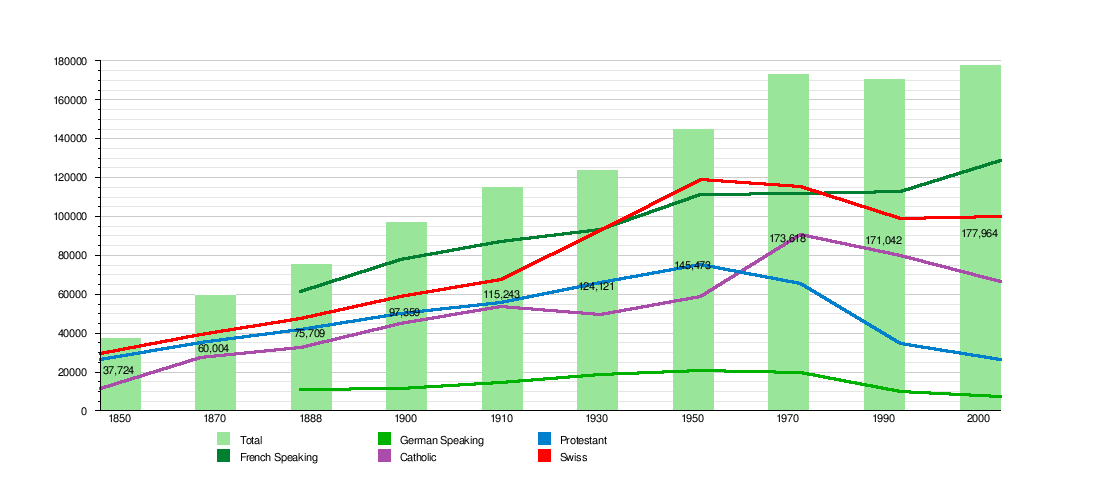
| Historic Population Data | |||||||||||
|---|---|---|---|---|---|---|---|---|---|---|---|
| Year | Total Population | German Speaking | French Speaking | Catholic | Protestant | Other | Jewish | Islamic | No religion given | Swiss | Non-Swiss |
| 1850 | 37,724 | 11,123 | 26,446 | 29,203 | 8,521 | ||||||
| 1870 | 60,004 | 27,092 | 35,064 | 39,012 | 24,507 | ||||||
| 1888 | 75,709 | 10,806 | 61,429 | 32,168 | 41,605 | 1,330 | 654 | 47,482 | 28,227 | ||
| 1900 | 97,359 | 11,703 | 77,611 | 44,958 | 49,875 | 1,918 | 1,055 | 58,376 | 38,983 | ||
| 1910 | 115,243 | 14,566 | 86,697 | 53,248 | 55,474 | 4,267 | 2,170 | 67,430 | 47,813 | ||
| 1930 | 124,121 | 18,717 | 93,058 | 49,531 | 66,016 | 4,584 | 2,224 | 92,693 | 31,428 | ||
| 1950 | 145,473 | 20,603 | 111,314 | 58,556 | 74,837 | 6,164 | 2,642 | 118,863 | 26,610 | ||
| 1970 | 173,618 | 19,657 | 111,553 | 90,555 | 65,393 | 22,591 | 3,128 | 959 | 6,164 | 115,107 | 58,511 |
| 1990 | 171,042 | 9,610 | 112,419 | 79,575 | 34,492 | 39,227 | 2,444 | 4,753 | 29,747 | 98,812 | 72,230 |
| 2000 | 177,964 | 7,050 | 128,622 | 66,491 | 26,020 | 34,972 | 2,601 | 8,698 | 41,289 | 99,935 | 78,029 |
Religion
Geneva has historically been considered a Protestant city, but substantial immigration from France and other predominantly Roman Catholic countries over the past century has changed its religious demography considerably. There were over twice as many Roman Catholics as Protestants living in the city in 2000. From the 2000 census, 66,491 or 37.4% were Roman Catholic, while 24,105 or 13.5% belonged to the Swiss Reformed Church, and 8,698 (or about 4.89% of the population) who were Muslim. Of the rest of the population, there were 3,959 members of an Orthodox church (or about 2.22% of the population), there were 220 individuals (or about 0.12% of the population) who belonged to the Christian Catholic Church of Switzerland, and there were 2,422 individuals (or about 1.36% of the population) who belonged to another Christian church. There were 2,601 individuals (or about 1.46% of the population) who were Jewish. There were 707 individuals who were Buddhist, 474 individuals who were Hindu and 423 individuals who belonged to another church. 41,289 (or about 23.20% of the population) belonged to no church, are agnostic or atheist, and 26,575 individuals (or about 14.93% of the population) did not answer the question. The headquarters of the Raelian movement are located within the city.
Economy
Geneva's economy is mainly services oriented. The city has an important and old finance sector, which is specialised in private banking (managing assets of about 1 trillion USD) and financing of international trade.
Geneva hosts the international headquarters of companies like JT International (JTI), Mediterranean Shipping Company,, Vitol, Gunvor, Merck Serono, SITA,, Société Générale de Surveillance, STMicroelectronics, and Weatherford International. Many other multinational companies like Caterpillar, DuPont, and Cargill have their international headquarters in the city; Take Two Interactive, Electronic Arts, INVISTA, Procter & Gamble and Oracle Corporation have their European headquarters in the city. Hewlett Packard has its Europe, Africa, and Middle East headquarters in Meyrin, near Geneva. PrivatAir has its headquarters in Meyrin, near Geneva.
There is a long tradition of watchmaking ( Baume et Mercier, Charriol, Chopard, Franck Muller, Patek Philippe, Gallet, Jaeger-LeCoultre, Rolex, Universal Genève, Raymond Weil, Omega, Vacheron Constantin, Frédérique Constant, etc.). Two major international producers of flavours and fragrances, Firmenich and Givaudan, have their headquarters and main production facilities in Geneva.
Many people also work in the numerous offices of international organisations located in Geneva (about 22,233 in March 2012).
The Geneva Motor Show is one of the most important international auto shows. It is held at Palexpo, a giant convention centre next to the International Airport.
In 2009, Geneva was ranked as the fourth most expensive city in the world. Geneva moved up four places from eighth place in last year's survey. Geneva is ranked behind Tokyo, Osaka, and Moscow at first, second, and third respectively. Geneva also beat Hong Kong, which came in at fifth place.
As of 2011, Geneva had an unemployment rate of 6.3%. As of 2008, there were five people employed in the primary economic sector and about three businesses involved in this sector. 9,783 people were employed in the secondary sector and there were 1,200 businesses in this sector. 134,429 people were employed in the tertiary sector, with 12,489 businesses in this sector. There were 91,880 residents of the municipality who were employed in some capacity, of which females made up 47.7% of the workforce.
In 2008 the total number of full-time equivalent jobs was 124,185. The number of jobs in the primary sector was four, all of which were in agriculture. The number of jobs in the secondary sector was 9,363 of which 4,863 or (51.9%) were in manufacturing and 4,451 (47.5%) were in construction. The number of jobs in the tertiary sector was 114,818. In the tertiary sector; 16,573 or 14.4% were in wholesale or retail sales or the repair of motor vehicles, 3,474 or 3.0% were in the movement and storage of goods, 9,484 or 8.3% were in a hotel or restaurant, 4,544 or 4.0% were in the information industry, 20,982 or 18.3% were the insurance or financial industry, 12,177 or 10.6% were technical professionals or scientists, 10,007 or 8.7% were in education and 15,029 or 13.1% were in health care.
In 2000, there were 95,190 workers who commuted into the municipality and 25,920 workers who commuted away. The municipality is a net importer of workers, with about 3.7 workers entering the municipality for every one leaving. About 13.8% of the workforce coming into Geneva are coming from outside Switzerland, while 0.4% of the locals commute out of Switzerland for work. Of the working population, 38.2% used public transportation to get to work, and 30.6% used a private car.
Infrastructure
Transport
The city is served by the Geneva Cointrin International Airport. It is connected by Geneva Airport railway station (French: Gare de Genève-Aéroport) with both the Swiss Federal Railways network and the French SNCF network, including to Paris, Lyon, Marseille and Montpellier by TGV. Geneva is connected to the motorway systems of both Switzerland ( A1 motorway) and France.
Public transport by bus, trolleybus or tram is provided by Transports Publics Genevois (TPG). In addition to an extensive coverage of the city centre, the network covers most of the municipalities of the Canton, with a few lines extending into France. Public transport by boat is provided by the Mouettes Genevoises, which link the two banks of the lake within the city, and by the Compagnie Générale de Navigation sur le lac Léman (CGN) which serves more distant destinations such as Nyon, Yvoire, Thonon, Évian, Lausanne and Montreux using both modern diesel vessels and vintage paddle steamers.
Trains operated by Swiss Federal Railways connect the airport to the main station of Cornavin in six minutes, and carry on to towns such as Nyon, Lausanne, Fribourg, Montreux, Neuchâtel, Bern, Sion and Sierre. Regional train services are being increasingly developed, towards Coppet and Bellegarde. At the city limits, two new stations have been opened since 2002: Genève-Sécheron (close to the UN and the Botanical Gardens) and Lancy-Pont-Rouge.
In 2011, work started on the CEVA (Cornavin – Eaux-Vives – Annemasse) project, first planned in 1884, which will connect Cornavin with the Cantonal hospital, Eaux-Vives station and Annemasse, in France. The link between the main station and the classification yard of La Praille already exists; from there, the line will go mostly underground to the Hospital and Eaux-Vives, where it will link to the existing line to France. Support for this project was obtained from all parties in the local parliament.
Taxis in Geneva can be difficult to find, and may need to be booked in advance especially in the early morning or at peak hours. Taxis can refuse to take babies and children because of seating legislation.
An ambitious project to close 200 streets in the centre of Geneva to cars has been approved in principle by the Geneva cantonal authorities, and is projected to be implemented over four years (2010–2014).
Utilities
Water, natural gas and electricity are provided to the municipalities of the Canton of Geneva by the state-owned Services Industriels de Genève (shortly SIG). Most of the drinkable water (80%) is extracted from the lake; the remaining 20% is provided by groundwater originally formed by infiltration from the Arve River. 30% of the Canton's electricity needs is locally produced, mainly by three hydroelectric dams on the Rhone River (Seujet, Verbois and Chancy-Pougny). In addition, 13% of the electricity produced in the Canton is made from the heat induced by the burning of waste at the waste incineration facility of Les Cheneviers. The remaining needs (57%) are covered by imports from other cantons in Switzerland or other European countries; SIG buys only electricity produced by renewable methods, and in particular does not use electricity produced using nuclear reactors or fossil fuels. Natural gas is available in the City of Geneva, as well as in about two-thirds of the municipalities of the canton, and is imported from Western Europe by the Swiss company Gaznat. SIG also provides telecommunication facilities to carriers, service providers and large enterprises. From 2003 to 2005, "Voisin, voisine" a Fibre to the Home pilot project with a Triple play offering was launched to test the end-user market in the Charmilles district.
Education
Geneva is home to the University of Geneva. In 1559 John Calvin founded the Geneva Academy, a theological and humanist seminary. In the 19th century the Academy lost its ecclesiastic links and in 1873 with the addition of a medical faculty, it became the University of Geneva. In 2011, the ranking web of universities ranked it 35th European university.
Located in the heart of International Geneva, The Graduate Institute of International and Development Studies was among the first academic institutions to teach international relations in the world and it proposes today MA and PhD programmes in Law, Political Science, History, Economics, International Affairs, and Development Studies.
Also, the oldest international school in the world is located in Geneva, the International School of Geneva, founded in 1924 along with the League of Nations.
The Geneva School of Diplomacy and International Relations is a private university on the grounds of the Château de Penthes, an old manor with a park and view of Lake Geneva.
The Canton of Geneva's public school system has écoles primaires (ages 4–12) and cycles d'orientation (ages 12–15). The obligation to attend school ends at age 15, but secondary education is provided by collèges (ages 15–19), the oldest of which is the Collège Calvin, which could be considered one of the oldest public schools in the world,., écoles de culture générale (15-18/19) and the écoles professionnelles(15-18/19). The écoles professionnelles offer full-time courses and part-time study as part of an apprenticeship.
Geneva also has a choice of private schools. However, out of all the educational and research facilities in Geneva, CERN (the European Organization for Nuclear Research) is probably the best known on a world basis and most recently renown for the Large Hadron Collider. Founded in 1954, CERN was one of Europe's first joint ventures and has developed as the world's largest particle physics laboratory. Physicists from around the world travel to CERN to research matter and explore the fundamental forces and materials that form the universe.
In 2011, 89,244 (37.0%) of the population have completed non-mandatory upper secondary education, and 107,060 or (44.3%) have completed additional higher education (either university or a Fachhochschule). Of the 107,060 who completed tertiary schooling, 32.5% were Swiss men, 31.6% were Swiss women, 18.1% were non-Swiss men and 17.8% were non-Swiss women.
During the 2011-2012 school year, there were a total of 92,311 students in the Geneva school system (Primary to University). The education system in the Canton of Geneva has eight years of primary school, with 32,716 students. The secondary school program consists of three lower, obligatory years of schooling, followed by three to five years of optional, advanced schools. There were 13,146 lower secondary students who attended schools in Geneva. There were 10,486 upper secondary students from the municipality along with 10330 students who were in a professional, non-university track program. An additional 11,797 students attended a private school.
Geneva is home to five major libraries, the Bibliothèques municipales Genève, the Haute école de travail social, Institut d'études sociales, the Haute école de santé, the Ecole d'ingénieurs de Genève and the Haute école d'art et de design. There were (as of 2008) 877,680 books or other media in the libraries, and in the same year 1,798,980 items were loaned.
International organizations
Geneva is the European headquarters of the United Nations, in the Palace of Nations building (French: Palais des Nations), which was also the headquarters of the former League of Nations. Several agencies are headquartered at Geneva, including the United Nations High Commissioner for Refugees (UNHCR), the United Nations High Commissioner for Human Rights (UNHCHR), the World Health Organization (WHO), the International Labour Organization (ILO), International Telecommunication Union (ITU) and the World Intellectual Property Organization (WIPO).
Apart from the UN agencies, Geneva hosts many inter-governmental organizations, such as the World Trade Organization (WTO), World Meteorological Organization (OMM), the World Economic Forum (WEF), the International Federation of Red Cross and Red Crescent Societies (IFRC), the International Organization for Migration (IOM) and the International Committee of the Red Cross (ICRC).
Organizations on the European level include the European Broadcasting Union (EBU) and the CERN (European Organization for Nuclear Research) which is the world's largest particle physics laboratory.
The Geneva Environment Network (GEN) publishes the Geneva Green Guide, and extensive listing of Geneva-based global organisations working on environment protection and sustainable development. A website (by the Swiss Government, WBCSD, UNEP and IUCN) includes stories about how NGOs, business, government and the UN cooperate. By doing so, it attempts to explain why Geneva has been picked by so many NGOs and UN as their headquarters location.
Geneva in popular culture
- Belle du Seigneur by Albert Cohen, ISBN 2-07-040402-1
- Her Lover (Belle du Seigneur) by Albert Cohen, ISBN 978-0-14-118830-0
- Nuages dans la main, Comme le sable, Le Creux de la vague, Jette ton pain by Alice Rivaz
- Eleven Minutes by Paulo Coelho
- Frankenstein by Mary Shelley
- Politics and the Arts by Jean-Jacques Rousseau
- Angels & Demons by Dan Brown
- Daisy Miller by Henry James
- This Perfect Day by Ira Levin
- His Dark Materials by Philip Pullman
- The Da Vinci Code by Dan Brown
- " Generation A" by Douglas Coupland, 2009
- Doctor of Geneva by Wallace Stevens
- Doctor Fischer of Geneva by Graham Greene
- The Unbearable Lightness of Being by Milan Kundera
- Asterix in Switzerland by René Goscinny and Albert Uderzo
- The Calculus Affair by Hergé
- Le Voyage De Sa Vie by Lisa Ray Turner
- The Chicago band Russian Circles 2009 album is entitled Geneva
- The song "Goin' Down Geneva" by Van Morrison opens his 1999 record Back on Top
- Ted Mosby from How I Met Your Mother sometimes wears a shirt with the Coat of Arms of Geneva printed on it.
- Three Colors: Red by Krzysztof Kieślowski.
Notable people
- Jean-Jacques Rousseau
- Jacques Necker, financier and statesman
- Albert Gallatin, financier and statesman
- Ferdinand de Saussure, professor of linguistics
- Henri Dunant, founder of the International Red Cross
- Flore Revalles, singer, dancer and actress
- Michel Simon, actor
- Alain Tanner, film director
- Frank Martin, composer
- Philippe Senderos, footballer
- Reto Ziegler, footballer
- Léon Savary, writer and journalist
- Marc Rosset, tennis player
- Jean-Louis Prévost, neurologist
- Swiss aviation pioneers:
- Emile Taddéoli
- Armand Dufaux
- Henri Dufaux
- Tariq Ramadan, writer, professor, philosopher
- John Armleder, Artist
- Germain Henri Hess, chemist
- Thomas Jouannet, actor
- Sarah Lahbati, actress, singer
- Katerina Graham, actress, singer and modell;she played Bonnie Bennett in The Vampire Diaries
- Julie Ordon, model and actress
- Kate Burton, actress, the daughter of actor Richard Burton
- Stephanie Morgenstern, actress, filmmaker, and screenwriter
- Germaine Aussey, actress
- Marie Laforêt, singer and actress
- Edna Best, actress
- Terry Southern, author, essayist, screenwriter
- Philip Arditti, actor

